Creating consistent and effective portion sizes presents an excellent opportunity for most bars to improve profitability. This is a topic that often gets addressed when you open your bar, but in most instances it is rarely revisited. When these pouring assumptions are taken for granted, it creates the potential to leave a lot of money on the table.
It’s always a good idea to evaluate your portion sizes once a year and make sure your glassware accurately reflects these decisions. This will ensure that your bartenders have the ability to make an accurate pour while still providing a generous looking drink to your customers.
Ideally, you should use research, discussion and calculations to make very conscious decisions about your pouring assumptions. It’s always best to make these decisions as a group by including your managers and bar staff. This will help ensure everyone is on the same page and serving consistent portion sizes.
Ultimately, this is the most effective way to make sure your portions don’t evolve over time to become so large that they cost you profits. We recommend that you use a scale and water to measure your glassware. This will help you determine whether your glasses are holding the correct portion size for your drinks. If they are too large, your bartenders will end up overpouring, which will cost you a lot of money in the long run.
Establishing Draft Beer Portion Sizes
It’s common to set a 14.5 oz. portion size for a 16 oz. glass. This 14.5 oz. pouring assumption creates an appropriate amount of head on your beers. Ideally, the amount of head on a beer poured in a 16 oz. glass should be about the height of a dime.
You should always double check your glass brands from time to time. There isn’t always consistency in sizing between different glass brands and as a result, not all brands have a truly accurate 16 oz. glass. Some brands will have a false bottom on the glass, resulting in it being closer to 14 oz. than 16 oz.
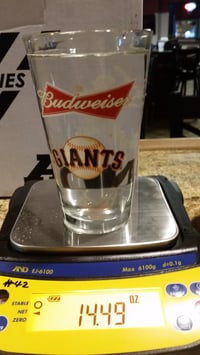
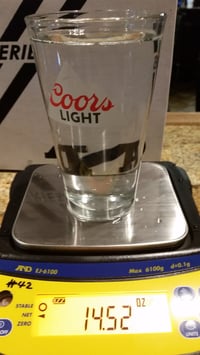
In addition, some manufacturers are more concerned with branding than portion sizing. This is particularly true when you receive free glassware. Research has shown that using branded glassware encourages customers to buy beers from that particular brand.
For example, serving Stella in a special branded Stella glass can often increase sales for this particular beer. This causes distributors and product manufacturers to push these custom branded glasses. However, if they don’t accurately reflect the pouring assumption you’ve established for that particular beer, you can end up losing a significant amount of money due to overpouring.
Keep the following items in mind when establishing pouring assumptions for the draft beers you serve:
- Custom glassware requires customized pouring assumptions – If you have 6 beer lines and use 6 different custom glasses for these beers, the chances that all of these custom glasses are exactly 16 oz. is very small. Therefore, you need specific customized assumptions for each different glass that you use, and you’ll need to make sure that your bartenders use the correct glass every time they pour that particular beer. Otherwise, it’ll be very difficult to ensure proper portion sizes for each beer, and this will be reflected in inventory results that show discrepancies between what was poured vs. what was sold.
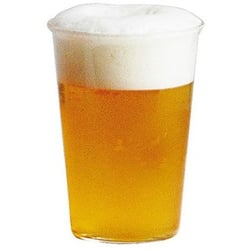 Beware of using plastic cups – Often, plastic cups are slightly larger than the pint glasses you’re using. We’ve seen some of our higher volume clients that use plastic cups on busy nights end up with 16.5 oz. pours when they use plastic cups compared to 14.5 oz. pours when they use pint glasses.
Beware of using plastic cups – Often, plastic cups are slightly larger than the pint glasses you’re using. We’ve seen some of our higher volume clients that use plastic cups on busy nights end up with 16.5 oz. pours when they use plastic cups compared to 14.5 oz. pours when they use pint glasses.
These beers are all rung in using the same POS button, which means you have 2 different pour sizes being rung in with 1 POS button. As a result, there’s no way to verify that these pours are correct. This extra 2 ounces of beer being poured every time you use plastic cups will add up and cost you a lot of money over time.- Not all beers create the same amount of head – Domestic beers and ciders don’t hold head, so we typically use a slightly tighter pouring assumption than we do with craft beers which hold head better.
- Consider using a 14 oz. glass to price beers more aggressively – At Bar-i, we like to call this the “dark arts of portioning.” In most instances, customers won’t notice if you’re using a 14 oz. glass instead of a 16 oz. glass. Typically, your customers will notice the price more than the portion size being provided, and using a 14 oz. glass allows you to price your beers more aggressively.
You should always be upfront with your customers if you use a 14 oz. glass (make this information available, but don’t broadcast it). But by using a smaller portion size and pricing your beers more aggressively, it can potentially increase sales and improve your business. - Trust but verify – You should trust your bartenders to make the correct pours, but you still need to check what’s being poured vs. sold in order to ensure your staff is doing their job correctly and not sacrificing profits due to overpouring.
Using an inventory system that provides this level of granularity in the data being produced will ensure your drinks are being poured correctly and boost profits. At Bar-i, we verify all of our results down to the serving, ensuring you have the accurate data necessary to verify that your bartenders are pouring the correct portion sizes.
Establishing Portion Sizes for Liquor Drinks
As with draft beer products, it’s crucial that you carefully think through your pouring assumptions for liquor drinks and regularly check to make sure your bartenders are pouring the correct portion size.
 Approximately 80% of our clients use a 1.5 oz. portion size for cocktails. This is typically considered “industry standard” for cocktails. Most bars that don’t use a 1.5 oz. pouring assumption will typically use a 1.25 oz. portion size. In rare cases, you may encounter a 1 oz. portion size for cocktails, but this usually only occurs in Vegas casinos and very corporate establishments.
Approximately 80% of our clients use a 1.5 oz. portion size for cocktails. This is typically considered “industry standard” for cocktails. Most bars that don’t use a 1.5 oz. pouring assumption will typically use a 1.25 oz. portion size. In rare cases, you may encounter a 1 oz. portion size for cocktails, but this usually only occurs in Vegas casinos and very corporate establishments.
While cocktails are typically poured using a 1.5 oz. portion size, you may want to consider a smaller portion size for shots. At Bar-i, we recommend using smaller shot glasses because it allows you to sell the shots at a lower price than your cocktail. For example, if you sell a 1.5 oz. Jack Daniels cocktail for $9, you can sell a 1 oz. Jack Daniels shot for $6 and make the same profit, or you can sell the 1 oz. shot for $7 and make a slightly larger profit.
Often, you might be able to sell a few more shots each night if they’re priced aggressively. Most people like taking shots, and there is a very social aspect of doing shots with your friends. By serving a 1 oz. shot that is slightly cheaper than a 1.5 oz. cocktail, you can often get your customers to order 1-2 shots along with their drinks. This will increase check sizes, as well as your profits.
There’s one other important reason to consider using a 1 oz. portion size for your shots. It will result in more responsible service. It’s very easy to overserve a customer who orders a lot of shots, but by using a smaller shot size, it will take a lot longer for these people to get really wasted. Ultimately, reducing the number of severely wasted people in your bar is better for business.
You’ll also want to avoid the following pitfalls when creating your pouring assumptions for liquor drinks:
- Beware of using promo glassware – Consider the following example that demonstrates the pitfalls you can experience when you use specialty Jägermeister shot glasses. The first picture shows a regular 1.5 oz. shot glass filled to the top to give you a 1.5 oz. shot. The second picture uses a special promo plastic Jägermeister shot glass, and the same 1.5 oz. pour doesn’t go all the way to the top. In the third picture, the special plastic promo shot glass is filled to the top, and it results in a 1.78 oz. shot. This is nearly a 20% overpour, which will start to significantly eat into your profits if you pour a lot of shots out of these promo glasses.
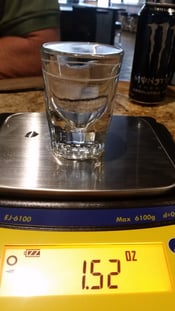
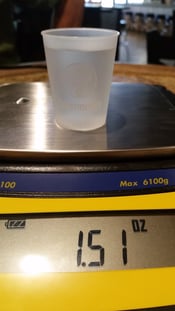

- Be careful to use appropriately sized glassware for rocks, doubles and martinis – Often, the portion size of these drinks is determined by the size of the glass instead of a set pouring assumption. This can result in serving a 5 oz. martini if you use a very large glass, which will cause you to lose money. Instead, we recommend coming up with a set pouring assumption for each of these drink types to ensure that they’re portioned correctly. Similarly, you should use appropriate glassware that will result in a 2 oz. rocks pour and a 3 oz. double pour.
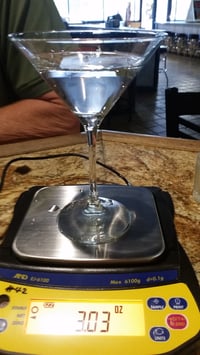
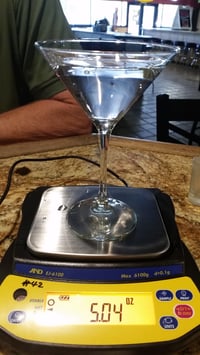
In most instances, it’s best to keep these drink offerings as simple as possible. If you have a cocktail, shot, rocks drink and martini drink with the same type of liquor, it requires you to program 4 separate buttons on your POS so that you can accurately account for the amount of liquor poured in each drink you serve. The more options you offer, the more complex your POS setup
Portion Sizes for Wine
A 6 oz. pour is by far the most common portion size for wine, but you might want to consider a 5 oz. pour to squeeze an extra glass out of each bottle. A 750 ml bottle of wine contains 25.4 oz. of wine, so a 5 oz. pour allows you to pour 5 full glasses instead of 4.
However, big wine glasses have become trendy in recent years, and a 5 oz. pour will look a bit skimpy in a large glass. If you serve wine in big glasses, you’ll want to stick to a standard 6 oz. pour so that your customers feel like they are getting a generous portion.
It’s also common for bars that do a large volume of wine sales to offer a 9 oz. option in addition to a 6 oz. option. If you choose to do this, just make sure that you price the 9 oz. option properly in order to avoid losing money.
As stated earlier, you need to be very careful if you use large glasses. It’s easy to put a lot of wine in these glasses and still have it look like a correct pour, when in fact you’ll be seriously overpouring, which will negatively impact your profitability.
There are several ways you can ensure a proper pour with a big wine glass:
- Fill up a wine glass with 6 oz. of rice or sugar so that the bartenders can see the proper level for a pour – The problem with this method is that it’s easy for the glass to get knocked over, making it difficult to be certain the amount of rice or sugar in the glass is correct.
- Put exactly 6 oz. in a glass and mark it with a sharpie – This way you’ll always know where the correct pour level is by comparing your glass of wine to the sharpie glass.
 Single portion carafes are a classy and effective option to ensure a proper pour – You can measure the level at which 6 oz. falls on the narrow part of the neck on the carafe, providing a great visual check for your bartenders. Then when customers order a second glass, you can just bring over a new carafe that will be poured into their old glass. This method reduces the amount of wine glasses used each night and provides a classy, tableside service vibe that many customers appreciate.
Single portion carafes are a classy and effective option to ensure a proper pour – You can measure the level at which 6 oz. falls on the narrow part of the neck on the carafe, providing a great visual check for your bartenders. Then when customers order a second glass, you can just bring over a new carafe that will be poured into their old glass. This method reduces the amount of wine glasses used each night and provides a classy, tableside service vibe that many customers appreciate.
Consistency is More Important than Your Actual Pouring Assumption
Keep in mind that maintaining consistency is much more important than your actual pouring assumption. It doesn’t really matter what pour sizes you ultimately decide to use. What matters is that everyone on your staff is on the same page regarding these portion sizes and makes an accurate pour every time they serve a drink. If your bartenders pour consistently and you price your drinks correctly based on the pour sizes you’ve established, you should be able to maintain a high profit margin on your alcohol sales. You can use our free liquor cost calculator to determine the appropriate price of individual drinks.
You’ll also want to use your inventory efforts to check the consistency of your bartenders’ pours on the back end. In order to effectively check this consistency, you’ll need a very precise inventory system that can measure the amount of alcohol poured down to the serving.
If you’d like to learn more about how Bar-i can help you improve your bar’s operations and maximize profitability, please contact us today to schedule a free consultation. We serve clients nationwide from our offices in Denver, Colorado.


-1.png)